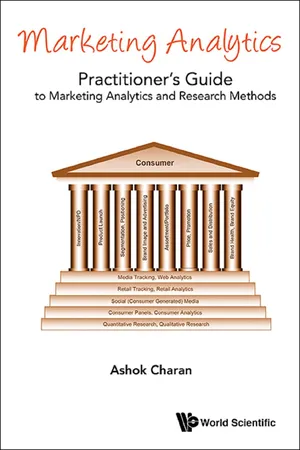
Marketing Analytics
A Practitioner's Guide to Marketing Analytics and Research Methods
- 720 pages
- English
- ePUB (mobile friendly)
- Available on iOS & Android
About This Book
The digital age has transformed the very nature of marketing. Armed with smartphones, tablets, PCs and smart TVs, consumers are increasingly hanging out on the internet. Cyberspace has changed the way they communicate, and the way they shop and buy. This fluid, de-centralized and multidirectional medium is changing the way brands engage with consumers.
At the same time, technology and innovation, coupled with the explosion of business data, has fundamentally altered the manner we collect, process, analyse and disseminate market intelligence. The increased volume, variety and velocity of information enables marketers to respond with much greater speed, to changes in the marketplace. Market intelligence is timelier, less expensive, and more accurate and actionable.
Anchored in this age of transformations, Marketing Analytics is a practitioner's guide to marketing management in the 21st century. The text devotes considerable attention to the way market analytic techniques and market research processes are being refined and re-engineered. Written by a marketing veteran, it is intended to guide marketers as they craft market strategies, and execute their day to day tasks.
For access to lecture presentations, case study datasets, and information on the topics covered in the text, visit the book's website at: http://bizfaculty.nus.edu/site/bizakc/MarketingAnalytics
The digital age has transformed the very nature of marketing. Armed with smartphones, tablets, PCs and smart TVs, consumers are increasingly hanging out on the internet. Cyberspace has changed the way they communicate, and the way they shop and buy. This fluid, de-centralized and multidirectional medium is changing the way brands engage with consumers.
At the same time, technology and innovation, coupled with the explosion of business data, has fundamentally altered the manner we collect, process, analyse and disseminate market intelligence. The increased volume, variety and velocity of information enables marketers to respond with much greater speed, to changes in the marketplace. Market intelligence is timelier, less expensive, and more accurate and actionable.
Anchored in this age of transformations, Marketing Analytics is a practitioner's guide to marketing management in the 21st century. The text devotes considerable attention to the way market analytic techniques and market research processes are being refined and re-engineered. Written by a marketing veteran, it is intended to guide marketers as they craft market strategies, and execute their day to day tasks.
For access to lecture presentations, case study datasets, and information on the topics covered in the text, visit the book's website at: http://bizfaculty.nus.edu/site/bizakc/MarketingAnalytics Contents:
- Brand:
- Brand and Brand Image
- Brand Equity
- Case I Shopper Trends — Food and Grocery Shopping in Singapore
- Consumer:
- Segmentation
- Qualitative Research
- Quantitative Research
- Customer Satisfaction and Customer Value
- Consumer Panels
- Consumer Analytics and Big Data
- Case II Vizag
- Case III Hectomalt
- Product:
- New Product Development
- Product Design
- Product Validation
- Case IV Hecto Grow
- Advertising:
- How Advertising Works
- New Media
- Digital Marketing
- Advertising Research
- Price and Promotion:
- Price
- Promotion
- Market Mix Modelling
- Case V Yakult
- Retail
- Retail Tracking
- Retail Analytics
- Sales and Distribution
- Category Management
- Case VI Little People
- Case VII Inulas
- Appendices:
- Sampling
- Gain–loss Algorithms: Assumptions/Limitations
- References
- Subject Index
- Company and Product Index
- People and Place Index
- Key Features:
According to an ex-P&Ger, P&G "was like a marketing university. You were always learning." And what you learnt was not taught at business schools. Not surprisingly P&Gers are highly valued. A LinkedIn search by AdvertisingAge in 2012 revealed that there were 100 CMOs of other companies who started their careers at P&G. The company has produced an even greater number of CEOs (713 based on AdvertisingAge's search) including marketers such as Bart Becht, Mitch Barns, Fabrizio Freda and Paul Polman.
But, what if you are not one of the fortunate few to have benefited from the P&G University or the School of Unilever?
You would expect that there would be a book or two that you could refer to. But oddly enough, while there are plenty of books on marketing, until now, there were none that were truly practitioner oriented. Ashok has been teaching for over 10 years, without prescribing a text. And as the refrain from his students, old students, academics and practitioners (including ex-P&Gers) grew louder, he got down to writing.
His book, Marketing Analytics, is the practitioner's guide to marketing management in the 21st century. It covers the marketing concepts and the marketing mix from the viewpoint of execution, devoting considerable attention to the analytic techniques and research practices that are required for effectively managing your brands on a day to day basis. It is written in an easy to understand style, with the intent to teach, as well as to excite and inspire.
You can click on this link for more information on the topics covered in the text. The website also provides access to lecture presentations, case studies, as well as snippets from the book.
Frequently asked questions
Information
PART I
Brand
CHAPTER 1
Brand and Brand Image

Pink Diamonds?
Preview
Lesson from the Summer of 1985

Brand
Table of contents
- Cover page
- Title page
- Copyright page
- Dedication
- Preface
- Acknowledgement
- Author
- Contents
- Part I Brand
- Part II Consumer
- Part III Product
- Part IV Advertising
- Part V Price and Promotion
- Part VI Retail
- Appendices
- References
- Subject Index
- Company and Product Index
- People and Place Index